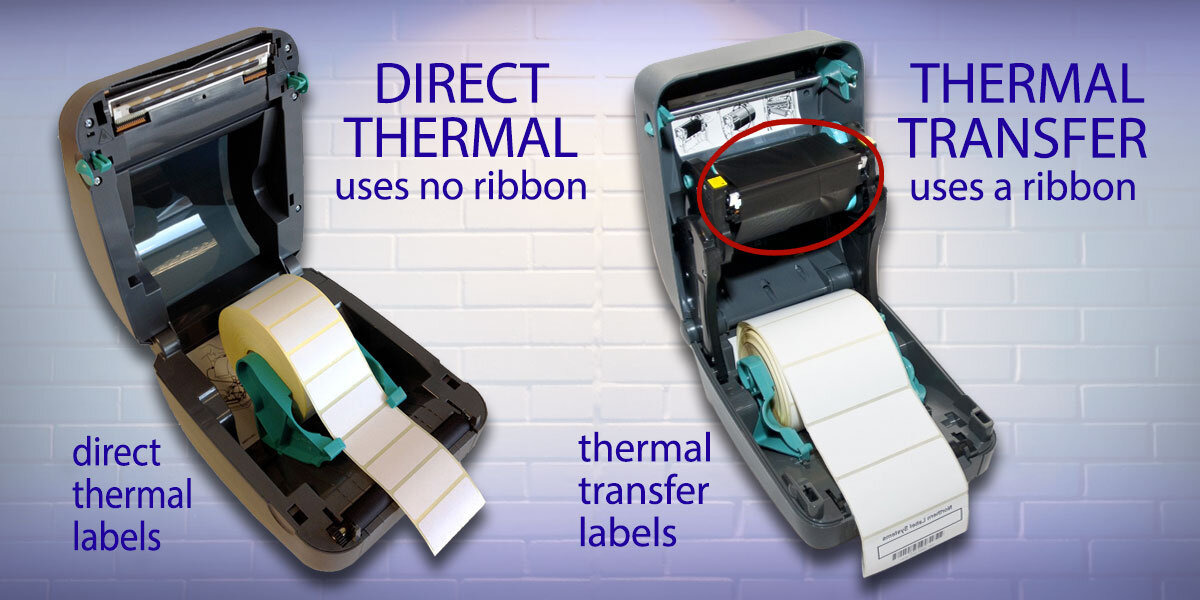Choosing the Right Barcode Printer
Barcode Factory sells hundreds of thermal printers to a myriad of business types every year. The label printer(s) you use was probably driven by whatever model the first person at your business ever bought on day one. Is that still the right choice? Hey, if it prints labels it's fine, right? Well, maybe and maybe not.
Thermal printers come in two types:
Direct Thermal and Thermal Transfer.
This choice is primarily based on the longevity of the label, tag, or receipt you want to print. Direct Thermal labels have a lifespan of between six months and a year. They print, without a ribbon, because the label’s coating is basically heat-activated. The printhead makes the label coating turn black wherever you determine. Barcodes are sharp as well as text. (Most shipping labels are printed using Direct Thermal material).
If you're looking for a more permanent label or even and an extremely durable label, your choice will be a Thermal Transfer Label, printed on a Thermal Transfer printer. This process requires you to use a Thermal Transfer Ribbon. The ribbon and label material come together inside the printhead and the image you want is pressed/heated onto the label material.
Printers Sizes - Desktop, Midrange, Industrial or Mobile.
This decision is strongly based on "how many labels" you print per day and the environment in which the printer operates. If you run a distribution center, with 20 loading docks and ship out 1,000 packages per day, an Industrial or Midrange printer will be your only choice. Industrial or Midrange printers will print at faster print speeds and hold larger rolls of labels. Desktop printers are a good choice for many small businesses, but their duty cycles need to match your needs. Mobile Printers are used extensively in the delivery of packages and in the warehouse or retail box store as an immediate label solution. Choosing between manufacturers such as Zebra, Honeywell, Sato, Intermec or others is best accomplished by asking the advice of our sales representatives. We will help identify which brands and models would best for your application so you can get the most out of your printer.
What size label, what size DPI?
Often called "barcode printers" because one or more barcodes, along with descriptive text, are used on most labels. The heart of any thermal printer is its printhead. Starting at 203 dpi and moving up through 600 dpi, the quality, sharpness and ability to print very small barcodes and text increases (see samples). Some, but not all, barcode printers have interchangeable printheads, however, unless the type of label your printing changes dramatically, you should choose a printhead that will meet most of your labeling needs. A general rule of thumb is the larger the label, the lower DPI printheads can be used, like 203 dpi and 300 dpi. The smaller the label, and barcode, sharper lines and text can only be achieved with 600 dpi and greater. An example is the jewelry industry uses 600 dpi exclusively for labeling small rings and watches.
NOTE: Always test the barcode you are printing with a scanner, if it's too small to scan the label will be useless.
Connectivity
Seems rather simple but there are many options for connecting your printer to your computer. As technology evolves many things disappear. Remember the floppy disk? Thermal printers have kept older connection options such as parallel ports. Planning ahead is always a good idea considering newer connectivity offers faster speeds. Most printers use USB, Ethernet, Wireless LAN, and Bluetooth for communication.
Software
Merging your data with a thermal printer and creating a label is unique for each business, but not uncommon. Thermal printers are capable of reading many printer languages including ZPL (Zebra's Proprietary Language) and more. Creating labels from scratch is done with a low-cost label creation program called BarTender, by Seagull Scientific. Many software types and versions are available for a large enterprise or small business.
Label & Ribbon Media
Labels are considered a commodity by many, especially shipping labels. While we don't disagree, we know that the paper stock on some very inexpensive labels will eventually wreak havoc on your printhead using direct thermal printers. Choosing the right label and ribbon combination in a thermal transfer printer is mandatory. Thermal transfer labels are available in a variety of standard paper or specialty synthetic materials to match the durability your application requires. Thermal ribbons are wax, wax-resin, or full resin, to match the proper label material. This is where a call to a professional will save you time and money. Once you find a combination that works, it's a good idea to stick with it. Barcode Factory offers free samples of labels and ribbons.
Extras – Think Productivity
When those labels come out of the printer they need to go somewhere. If you're printing one or two at a time, there's no need, but if you print hundreds at one time, your need to handle these labels. Label Handling equipment, such as Rewinders and Dispensers, can take an entire 8-inch roll of labels and wind them onto an empty roll in minutes with no oversight. If employees need to label products repetitively, Automatic Label Dispensers will pay for themselves in short order.
For fast and productive answers to all your questions Contact a Barcode Factory Representative



